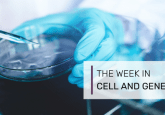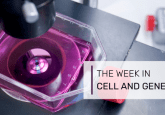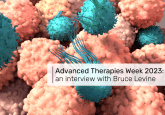Facilitating cell and gene manufacturing with digitalization: an interview with Paul Viggers

 At the Advanced Therapies Europe conference (31 August–1 September 2022, London, UK), we spoke with Paul Viggers, Chief Commercial Officer of TrakCel (Wales, UK) all about the newly updated OCELLOS platform. Through digitalizing the cell and gene manufacturing process, Paul explains how this innovative product is catering to unmet need in the market, facilitates the shift towards commercialization, enables supply chain streamlining and much more. Make sure to read the full interview below.
At the Advanced Therapies Europe conference (31 August–1 September 2022, London, UK), we spoke with Paul Viggers, Chief Commercial Officer of TrakCel (Wales, UK) all about the newly updated OCELLOS platform. Through digitalizing the cell and gene manufacturing process, Paul explains how this innovative product is catering to unmet need in the market, facilitates the shift towards commercialization, enables supply chain streamlining and much more. Make sure to read the full interview below.
Please could you introduce yourself and your company?
My name is Paul Viggers, and I am the Chief Commercial Officer at TrakCel. We provide Cell Orchestration Solutions (COS) to the global cell and gene therapy industry. We have developed and are deploying a digital platform called OCELLOS by TrakCel (OCELLOS), which is utilized to support cell and gene therapy developers and their supply chain partners to orchestrate their complex value chains.
How do you think that this area of digitalization can cater to an unmet need in the cell and gene therapy space?
When you think about cell and gene therapy and the complexity of the supply chain, there is a lot of human interaction in terms of the management of, most importantly, the patient. For example, it’s imperative that the patient reaches the hospital and research facility on time. Then, there is the management and booking of logistics and manufacturing schedules to consider. This is just the logistics element of the cell and gene therapy value chain and when you put all of that together, there are a lot of complexities involved in ensuring that everything is coordinated, particularly as you are handling live cells often within incredibly tight time constraints. Ultimately, the aim is to make sure that you get the right treatment to the right patient on time.
Utilizing a software solution such as OCELLOS enables each user in the process– whatever their role and level within their specific organization – to be assured that they can perform their task whilst knowing that the next person in the supply chain is also ready to perform their tasks. Digitalization streamlines what can be a manually intensive process, for example, it means that there is no longer the need to manually book a courier to pick up the shipment or to look at the manufacturer’s schedule – all of this is done within the digital OCELLOS platform, using algorithms and integrations to tie the complex processes together.
How do you succeed in bringing together all these diverse groups to form mutually beneficial partnerships?
We work with the drug manufacturer themselves who are often the sponsors of the trial and who will have their preferred suppliers and clinical and commercial sites already identified. So, we work with that single point of contact – the drug manufacturer – and they will then purchase licences and hand them to each persona within their supply chain. This means that, if they had a clinical site, they would provide licences to that clinical site who would input the patient information into the COS. The sponsor may also have somebody internally who is responsible for booking the logistics within OCELLOS via an integrated courier. In summary, the manufacturer will look at who in the supply chain needs access to what information and set licences and notification accordingly so that it is shared in real-time.
What challenges will we come up against when trying to digitalize cell and gene therapy?
I think the one of the main challenges is that people believe that they can still manage cell and gene therapy on a paper-based system. Yes, you can – but you must seriously consider scalability especially as clinical trials move towards commercialization and the potential of a significant increase in patient numbers.
If you think of an autologous process which involves cell extraction from the patient, shipping the cells to the manufacturing facility and shipping them back to the correct patient – it sounds very simple with just one patient. However, as you multiply that to 10, 100 or 10,000 patients, it’s very different. Patients are likely to be scattered all over the world with different time zones, different shipping routes and regulatory requirements. The routing and processing then become almost impossible.
However, using software such as OCELLOS, means that all stakeholders will be able to have a view on what’s happening at every stage of a patient’s journey. It allows the therapy developer to see a bird’s eye view of exactly what is going on for all patients, at all sites around the world and at what stage of the process every patient is at. The main challenge going forward with this is to get the sponsors and therapy developers to think about scalability from the on-set – if they deploy the OCELLOS platform early on, then their business and value chain can grow easily based on consistent processes as their trials develop and as they move into the commercial sphere.
How do you go about making potential clients understand the necessity of digitalization?
It is ultimately about walking clients through the various scenarios and sharing the potential returns on investment that they could benefit from. For example, we have clients that are looking to recruit a team of supply chain managers to handle their supply chain, but with automated COS, that team could easily be two rather than eight full time people. If we get them to think of the extra investment it would take to recruit six more people versus the investment of our platform that will continue to scale to support them longer-term, they immediately can see and understand the benefits of a digitized platform.
Secondly, you must think about risk – if processes are being manually handled from phone calls and spreadsheets, there is a significant risk from a quality perspective as there is potential for human error. Additionally, this poses issues around traceability, whereas if you’re utilizing OCELLOS, the chain of identity and custody is always tracked – you have the timestamp, there is evidence of exactly who did the task and when they did it. Additionally, if something has been changed in the system you can what has changed and who changed it. So, you have that full traceability. Traditionally collected and stored information is very difficult to trace, and you don’t know if it’s been changed, deleted, typed over – you simply don’t know.
Do you think that staff need a lot of training to be able to utilize the OCELLOS system?
TrakCel launched OCELLOS last year with user interface in mind. We wanted to make it as simple for our users as we possibly could and consequently, it is very intuitive and user friendly. For example, like most online forms, if it has an asterisk, this means this section is mandatory to complete and if it doesn’t, you know that section is optional. Additionally, there are guides throughout each stage of the process, where you can hover over a section and the guide will tell you exactly what needs to be input.
However, where users or organizations feel that additional support would be beneficial, there is an online portal with training videos, or we can work with clients to provide live training sessions. For clients, once logged into the platform, there is training available for them to complete with records produced if needed.
Do you think that digitalization could facilitate this process of streamlining?
I think so. As digitalization can help keep processes working within specified timescales, I feel that the sector will grow and that, more importantly, timeframes of manufacturing can be reduced. Sometimes patients’ cells, need a turnaround time of 96 hours, for example, so every second counts. We’re already seeing the benefits of utilizing our platform, with our clients being able to reduce their timeframes because they can make that booking immediately online and not have to wait for somebody to confirm it or answer the phone. They can see availability in real time.
Also, I think a key element concerns localization and language. For example, if you have a manufacturing facility in the US and the hospital site is in France, we want to ensure that the user can decide on what language the platform is in – do they want it in the local language? With OCELLOS, we always ask our clients their language preference, again because we want to cater to the user’s experience.
The system also gives the option to select the scheduling time zone that users know what time the product is being collected and arriving. This ensures that there’s no room for time zone errors.
What do you think will be the biggest change in the next five years and where would you like the field to go in this time?
I think we’re already starting to see some of the change concerning digitalization, although there may very well be different views on this within the cell and gene therapy field as the industry continues to mature. We’re certainly starting to see increasing approvals of commercialized cell and gene therapies – more approvals over the next five years will require standardization and higher levels of regulatory control which will only grow and enhance this continually changing and evolving sector.
You might also like:
- 3 ways to improve sustainability in advanced therapies
- In Focus: sustainability in cell and gene therapy
Disclaimer
The opinions expressed in this interview are those of the interviewee and do not necessarily reflect the views of RegMedNet or Future Science Group.





